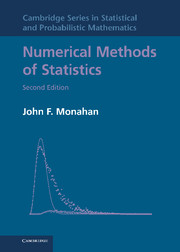42 results
10 - Numerical Integration and Monte Carlo Methods
-
- Book:
- Numerical Methods of Statistics
- Published online:
- 01 June 2011
- Print publication:
- 18 April 2011, pp 257-302
-
- Chapter
- Export citation
9 - Maximum Likelihood and Nonlinear Regression
-
- Book:
- Numerical Methods of Statistics
- Published online:
- 01 June 2011
- Print publication:
- 18 April 2011, pp 219-256
-
- Chapter
- Export citation

Numerical Methods of Statistics
-
- Published online:
- 01 June 2011
- Print publication:
- 18 April 2011
11 - Generating Random Variables from Other Distributions
-
- Book:
- Numerical Methods of Statistics
- Published online:
- 01 June 2011
- Print publication:
- 18 April 2011, pp 303-342
-
- Chapter
- Export citation
1 - Algorithms and Computers
-
- Book:
- Numerical Methods of Statistics
- Published online:
- 01 June 2011
- Print publication:
- 18 April 2011, pp 1-12
-
- Chapter
- Export citation
Preface to the First Edition
-
- Book:
- Numerical Methods of Statistics
- Published online:
- 01 June 2011
- Print publication:
- 18 April 2011, pp xv-xvi
-
- Chapter
- Export citation
12 - Statistical Methods for Integration and Monte Carlo
-
- Book:
- Numerical Methods of Statistics
- Published online:
- 01 June 2011
- Print publication:
- 18 April 2011, pp 343-374
-
- Chapter
- Export citation
8 - Introduction to Optimization and Nonlinear Equations
-
- Book:
- Numerical Methods of Statistics
- Published online:
- 01 June 2011
- Print publication:
- 18 April 2011, pp 186-218
-
- Chapter
- Export citation
Subject Index
-
- Book:
- Numerical Methods of Statistics
- Published online:
- 01 June 2011
- Print publication:
- 18 April 2011, pp 444-447
-
- Chapter
- Export citation
3 - Matrices and Linear Equations
-
- Book:
- Numerical Methods of Statistics
- Published online:
- 01 June 2011
- Print publication:
- 18 April 2011, pp 40-66
-
- Chapter
- Export citation
Preface to the Second Edition
-
- Book:
- Numerical Methods of Statistics
- Published online:
- 01 June 2011
- Print publication:
- 18 April 2011, pp xiii-xiv
-
- Chapter
- Export citation
2 - Computer Arithmetic
-
- Book:
- Numerical Methods of Statistics
- Published online:
- 01 June 2011
- Print publication:
- 18 April 2011, pp 13-39
-
- Chapter
- Export citation
14 - Sorting and Fast Algorithms
-
- Book:
- Numerical Methods of Statistics
- Published online:
- 01 June 2011
- Print publication:
- 18 April 2011, pp 403-438
-
- Chapter
- Export citation
Contents
-
- Book:
- Numerical Methods of Statistics
- Published online:
- 01 June 2011
- Print publication:
- 18 April 2011, pp vii-xii
-
- Chapter
- Export citation
13 - Markov Chain Monte Carlo Methods
-
- Book:
- Numerical Methods of Statistics
- Published online:
- 01 June 2011
- Print publication:
- 18 April 2011, pp 375-402
-
- Chapter
- Export citation
5 - Regression Computations
-
- Book:
- Numerical Methods of Statistics
- Published online:
- 01 June 2011
- Print publication:
- 18 April 2011, pp 91-127
-
- Chapter
- Export citation
6 - Eigenproblems
-
- Book:
- Numerical Methods of Statistics
- Published online:
- 01 June 2011
- Print publication:
- 18 April 2011, pp 128-150
-
- Chapter
- Export citation
Frontmatter
-
- Book:
- Numerical Methods of Statistics
- Published online:
- 01 June 2011
- Print publication:
- 18 April 2011, pp i-vi
-
- Chapter
- Export citation
4 - More Methods for Solving Linear Equations
-
- Book:
- Numerical Methods of Statistics
- Published online:
- 01 June 2011
- Print publication:
- 18 April 2011, pp 67-90
-
- Chapter
- Export citation
7 - Functions: Interpolation, Smoothing, and Approximation
-
- Book:
- Numerical Methods of Statistics
- Published online:
- 01 June 2011
- Print publication:
- 18 April 2011, pp 151-185
-
- Chapter
- Export citation

